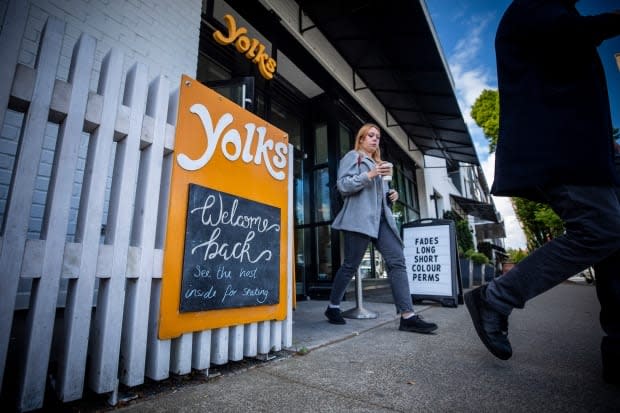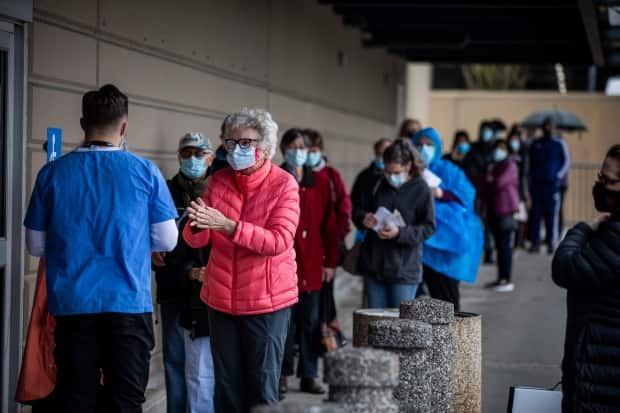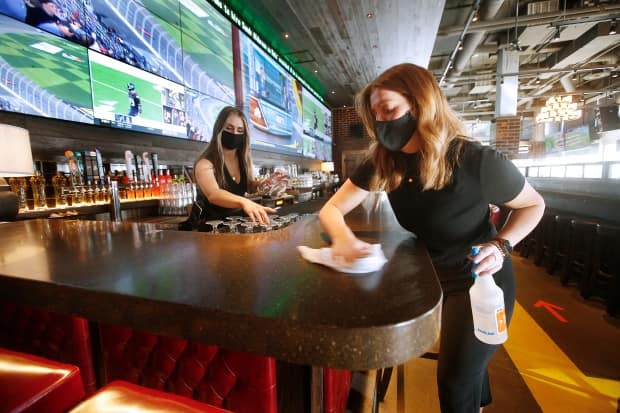Yes, provinces are preparing to reopen. But it's not time to ditch your mask just yet, experts say

As more regions in Canada start reopening, and millions of people return to restaurants, gyms, stores and salons, infectious diseases experts say there are some crucial precautions both business owners and individuals should maintain to prevent more infections.
Unlike in the North and the Atlantic provinces, where lower case counts meant more businesses could operate at closer-to-normal levels throughout much of the pandemic, several provinces hard-hit by COVID-19 cases are only easing their latest rounds of public health restrictions starting in the weeks ahead.
Alberta revealed its plan to fully reopen by early July on Wednesday, following on the heels of Saskatchewan, Quebec, Ontario and B.C. — provinces that are all aiming to gradually lift restrictions over the coming weeks and months, if case counts keep going down while vaccination rates go up.
That means shopping, dining, playing sports, working in an office, attending school in-person, and gathering with family and friends will all likely be part of daily life again soon in more regions.
"Yes, things are opening up," said Dr. Stephanie Smith, a professor in the infectious diseases division at the University of Alberta's department of medicine and the university's director of infection prevention and control.
"But we can't just abandon all the measures that we've put in place."
That means maintaining public health precautions such as mask-wearing, physical distancing and basic hand hygiene — and, in the case of some workplaces, upgrading their ventilation — during this transition period back to normal life, since many Canadians remain vulnerable and unvaccinated.
"We have to recognize that although our case numbers are going down ... there still is some COVID circulating in the community," Smith said.
Ventilation, mask-wearing both key
Infectious diseases specialist Dr. Srinivas Murthy, an assistant professor of medicine at the University of British Columbia, said Canadians need to be approaching transmission risk based on the most up-to-date understanding of how the virus transmits.
"In an ideal world, we would have clear public health guidance from each of our respective authorities," he said. "What you should and shouldn't do in this context."
The 3 Cs approach developed in Japan — avoiding closed spaces, crowded places, and close-contact settings — sums up the best lessons we've learned so far about how to curb transmission, Murthy said.
Epidemiological case studies have also reported long-range virus transmission beyond a few metres in a variety of indoor settings, such as churches, restaurants, concert halls and office buildings, notes a report released earlier this month from Public Health Ontario, which signals the need to boost airflow indoors or stay outside whenever possible.
WATCH | Regina physician explains why Canadians will likely be wearing masks awhile longer:
"It's easy to say, 'Open a window,'" said Smith. "But the reality is, when we start looking at mandating people to use HEPA filtration and everything, it's on a different level. There are costs associated with that."
So, it may be financially challenging for smaller businesses to address ventilation concerns. However, larger workplaces such as factories, which have been common sites for outbreaks, need to get to the root of their transmission problems and work with local public health officials to find solutions, Smith said.
"A store, for the most part, people are going in and out. They're in there for a very short period of time, and at this point, are masked," she said. "At a meat-packing plant, people are going to be working for eight hours a day and they're often in close quarters."
Improving ventilation is generally helpful, echoed Dr. Alex Wong, an infectious diseases physician in Regina. He said mask-wearing will also likely be a staple of daily life for months to come until more Canadians get vaccinated.
South of the border, the U.S. Centers for Disease Control and Prevention (CDC) recently eased indoor mask-wearing guidance for people who are fully vaccinated, allowing them to safely stop wearing masks inside in most spaces.
But Wong said since Canada's rate of fully vaccinated individuals still lags behind the U.S., we're not quite at that point yet, meaning face coverings remain a crucial tool to protect vulnerable individuals as more people start mingling and returning to workplaces.
"Masking continues to make a huge amount of sense in indoor, public spaces," he said.

Shift away from surface-based precautions
What makes less sense, according to Murthy, is for businesses and individuals to skip those measures while overly relying on methods to prevent surface-based transmission, which most researchers agree isn't a primary way people get infected.
"Way back when, when we were wiping down groceries or cleaning our fruit well to avoid COVID-19; we've learned a lot since then," he said.
That focus on surfaces started early on, and included practices such as office buildings investing in regular cleanings, cashiers wiping down debit machines, and mandatory hand sanitizer at storefront entrances.
At this point, Murthy is among those unsure about just how many infections are being prevented through those methods, with some experts even dubbing the practices "hygiene theatre" — an approach that promotes a feeling of safety, more than it actually contributes to stopping virus transmission.

"Current evidence strongly suggests transmission from contaminated surfaces does not contribute substantially to new infections," notes the latest guidance from the CDC.
According to Smith, there is a degree of fomite spread, but "it's certainly much less than we initially thought."
"Is handwashing important?" she said. "Yes, it still is."
Many experts do recommend that step as a precaution to prevent people from getting infected after touching their face or mouth.
Still, Murthy stressed that businesses and individuals should focus more energy on maintaining adequate distancing and ventilation as regions start reopening, "rather than aggressively emphasizing hand-sanitizing at every entry point."
Provinces at 'different points'
As more Canadians become fully vaccinated, or even get one dose, there's growing hope it will be easier to start lifting even the most stringent restrictions in the months ahead.
"If you're gathering in a group with people who are fully vaccinated, certainly the risk is much less," Smith said.
While Dr. Theresa Tam, Canada's chief public health officer, says provinces should only begin to lift public health restrictions once 75 per cent of adults have at least one vaccine dose — and 20 per cent are fully vaccinated — most provinces are moving at a quicker pace.
That's no surprise to Wong, who said different regions are at different points, meaning there's no universal, countrywide timeline for life to go back to normal.
In some Canadian regions, it's already closer to business as usual with various non-essential industries up and running, while the provinces set to reopen soon are finally experiencing dropping case counts as vaccination rates rise.
Meanwhile, Manitoba is actually extending restrictions during its devastating third wave as the province's ICUs keep filling up with COVID-19 patients, with some even being transferred to hospitals in Ontario.
"We're all at very different points of our curve," Wong said.

